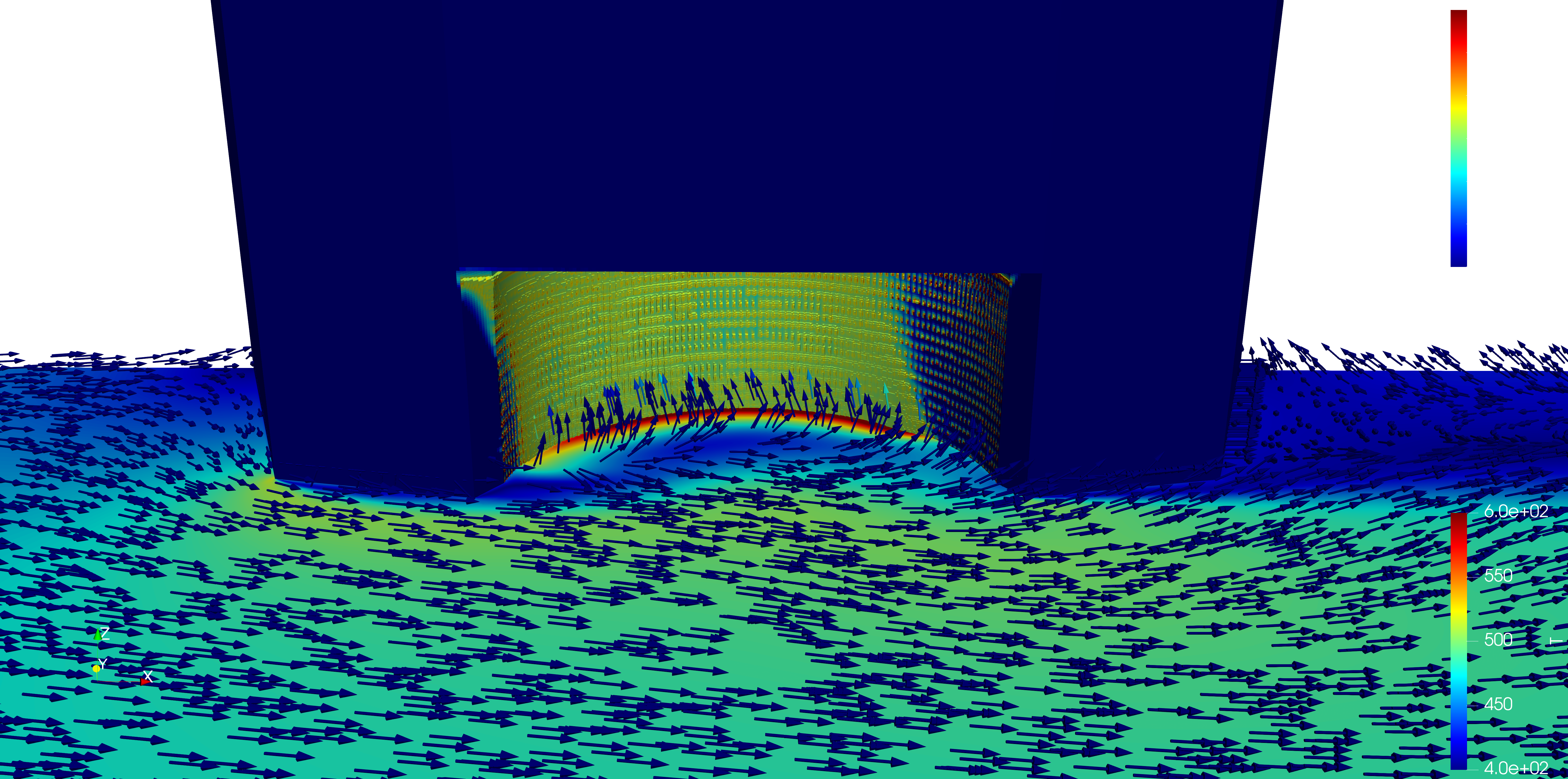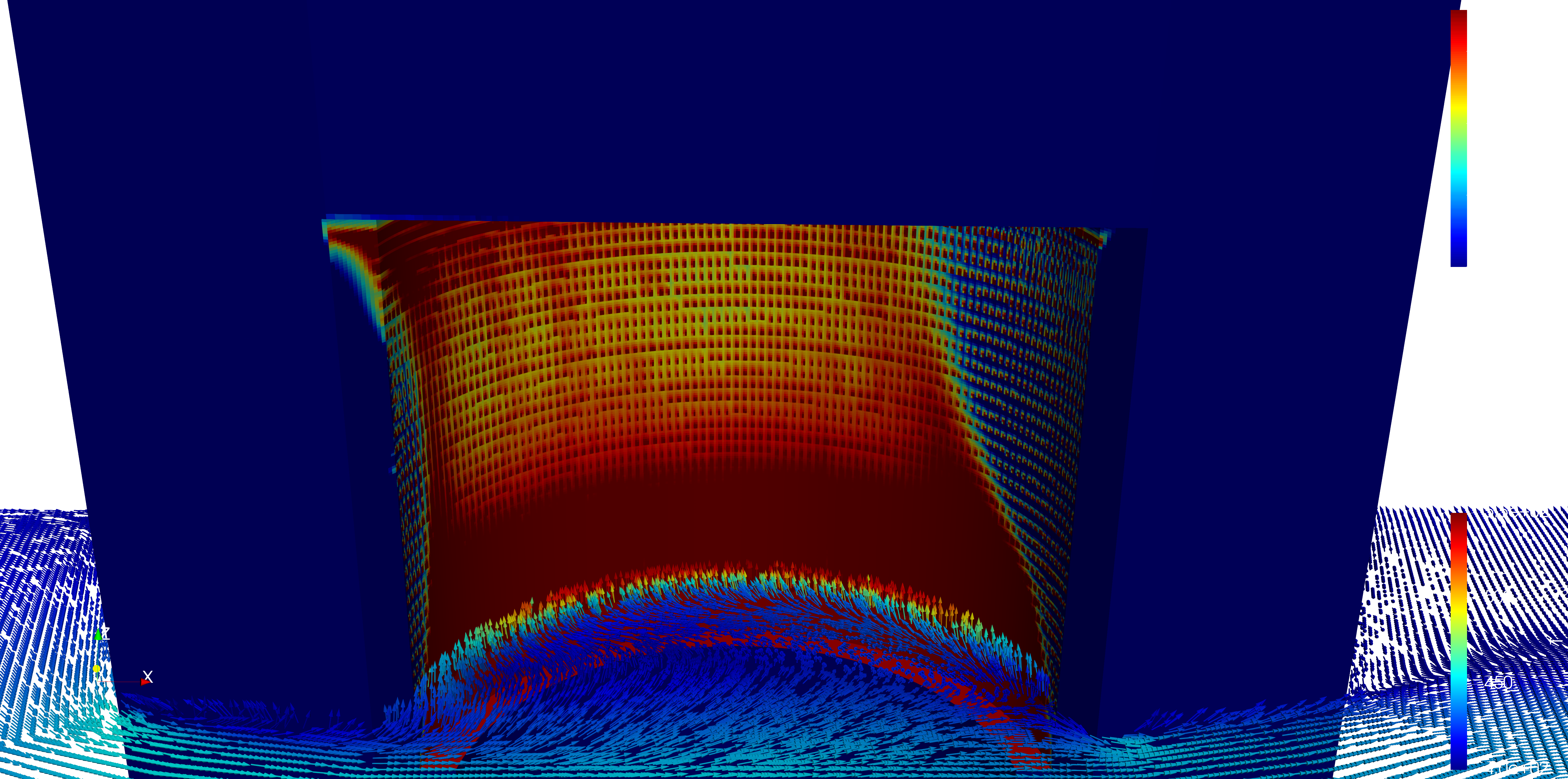Project
CFD Analysis of Wind Influence on Air Return Ratio and Thermal Efficiency of Open Volumetric Receivers in Solar Tower Power Plants
At the DLR – Institute of Solar Research new receiver technologies for concentrating solar power are researched. The open volumetric receiver consists of a porous structure that absorbs the concentrated irradiation. Ambient air is drawn into the porous structure and heated convectively (~ 700 °C) and is then transferred to a consecutive process. After that, the air (at 110 to 270 °C) is recirculated back to the front of the receiver in order to reuse the remaining exergy by recirculating as much of the “return air” as possible. In recent research projects an upscaling of the technology is investigated with tower heights up to 200 m and a concave receiver surface. Receiver losses consist of radiation losses and convective losses quantified by the completeness of the air return. In this project convective losses under the influence of ambient wind are quantified by means of CFD simulations in such a scaled-up receiver design. The size of the problem and the discrepancy in scales between the absorber structure and the whole tower result in numerical domains of 100 to 300 million elements, which necessitates the use of HPC.
Project Details
Project term
August 1, 2022–August 24, 2023
Affiliations
RWTH Aachen University
Institute
DLR - Institute of Solar Research - Chair of Solar Technology
Project Manager
Principal Investigator
Methods
To evaluate convective losses, the air return ratio is evaluated for different wind conditions and return air concepts. This is achieved by solving the Navier-Stokes equations and additional transport equations to determine the return air concentration at the receiver. The return air concentration is then evaluated as a mass flow weighted average over the receiver. Therefore, steady-state RANS simulations are performed using the Spalart-Allmaras turbulence model.
Results
The convective losses at the cavity-shaped open volumetric receiver are investigated at lateral wind conditions without and with 4 or 8 m/s wind. In the receiver concept half of the return air is recirculated through gaps between the porous absorber modules to cool the supporting structure while the rest is returned from an external outlet placed below the receiver. The first simulations reveal that there are local differences at the receiver regarding the completeness of air return which depend on the flow separation at the tower geometry and where the vortices impinge on the receiver. In particular, the air returned from below the receiver is disturbed by ambient wind and the return ratio drops from ~ 80 % to 67 % (4 m/s wind) to 65 % (8 m/s wind). Based on those findings countermeasures to reduce the losses of return air are numerically investigated. At first wind-adjusted return air distributions are proposed where under the influence of wind, the mass flow or outflow velocity are adjusted at those areas where the receiver is affected by ambient wind. The idea is to increase the outflow momentum so that the return air can withstand the impact of ambient wind. This approach has proven to be a successful measure especially at higher wind speeds and led to increases in rate of returned air of +4 to 5 % and an increase in inlet temperatures of ~8 K. In addition to that measure, the application of an air curtain has been investigated. In this concept, air at ambient temperatures is ejected from an additional outlet with the aim to deflect the incoming wind and prevent it from entering the receiver, ideally sealing the concave receiver. Different configurations including outlet angles and mass flows have shown that this measure is not applicable to receivers of this size, as the outflow impulse of the air curtain dissipates too early , resulting in the air curtain been drawn into the receiver, lowering the inlet temperature.
Discussion
It has been shown that ambient wind has to be considered in the evaluation of the receiver efficiency in large-scale open volumetric receivers. It was shown that especially externally returned air is vulnerable to ambient wind and that there are strong local differences at the receiver. As a countermeasure, locally adjustable return air outlets are proposed. In the application, this allows to react on dynamically changing wind conditions and has the potential to increase the receiver efficiency under the influence of wind. This research is limited by the fact that only lateral wind was investigated and should be expanded for more wind directions. Also, the return air outlet distributions can be further optimized by implementing a controller that adjusts the distribution during each simulation based on the evaluation of local receiver quantities.
Additional Project Information
DFG classification: 404-03 Fluid Mechanics
Software: Python3, OpenFOAM, ParaView
Cluster: CLAIX
Publications
Drexelius M., Schwarzbözl P., Pitz-Paal, R.,
Numerical analysis of wind-induced convective heat losses in Large-scale open volumetric cavity re-ceivers and the evaluation of countermeasures, Solar Energy, 2024:Vol 267

